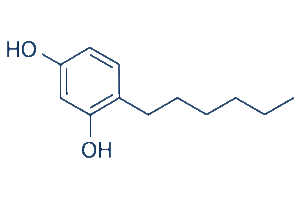This product is for research use only, not for human use. We do not sell to patients.

| Size | Price | Stock |
|---|---|---|
| 25g | $150 | Check With Us |
| 50g | $250 | Check With Us |
| 100g | $375 | Check With Us |
Cat #: V2637 CAS #: 136-77-6 Purity ≥ 98%
Description: Hexylresorcinol (4-Hexylresorcinol) is an organic compound with local anaesthetic, antiseptic and anthelmintic properties, is a potent inhibitor of mushroom tyrosinase. The IC50 values of hexylresorcinol for monophenolase is 1.24 μM and for diphenolase is 0.85 μM. Studies showed hexylresorcinol could inhibit both mono- and di-phenolase activity of mushroom tyrosinase. Moreover, hexylresorcinol at 2 μM lengthened the lag period from 98 s to 26. Hexylresorcinol could also display reversible inhibition of the enzyme.
References: Y. A. Nikolaev, et al. The use of 4-Hexylresorcinol as antibiotic adjuvant. PLoS One. 2020; 15(9): e0239147.
Publications Citing InvivoChem Products
Product Promise

- Physicochemical and Storage Information
- Protocol
- Related Biological Data
- Stock Solution Preparation
- Quality Control Documentation
| Molecular Weight (MW) | 194.27 |
|---|---|
| Molecular Formula | C12H18O2 |
| CAS No. | 136-77-6 |
| Storage | -20℃ for 3 years in powder formr |
| -80℃ for 2 years in solvent | |
| Solubility In Vitro | DMSO: 38 mg/mL (195.6 mM)r |
| Water: <1 mg/mLr | |
| Ethanol: 38 mg/mL (195.6 mM) | |
| SMILES Code | OC1=CC=C(CCCCCC)C(O)=C1 |
| Synonyms | 4-Hexylresorcinol |
| Protocol | In Vitro | In vitro activity: Previous research showed hexylresorcinol could inhibit both mono- and di-phenolase activity of mushroom tyrosinase. Moreover, hexylresorcinol at 2 μM lengthened the lag period from 98 s to 26. Hexylresorcinol could also display reversible inhibition of the enzyme. In addition, the kinetic analyses showed that hexylresorcinol was a competitive inhibitor with the apparent inhibition constant binding with free enzyme to be 0.443 μM for diphenolase Kinase Assay: Cell Assay: |
|---|---|---|
| In Vivo | Iin vivo study showed that hexylresorcinol could induce chromosome aberrations in mouse eukaryotic cells at doses of 0.5, 0.05, and 0.005 mg/g and the metabolic transformation of hexylresorcinol decreased its genotoxic effect in mice. Moreover, the mutagenic effect lasted for 3 days only at the highest dose of hexylresorcinol (0.5 mg/g). Thus, hexylresorcinol doses less than 0.5 mg/g were metabolized within two days to the extent of the cytotoxic effect. In addition, hexylresorcinol was transformed at a rate of 0.0025–0.025 mg/day after a single administration to mice | |
| Animal model | Male nude mice (BALB/cAnNCrj-nu/nu), with SCC-9 cells xenograft | |
| Dosages | 10 mg/kg | |
| Administration | Intraperitoneal injection, daily, for 16 days |
| Solvent volume to be added | Mass (the weight of a compound) | |||
|---|---|---|---|---|
| Mother liquor concentration | 1mg | 5mg | 10mg | 20mg |
| 1mM | 5.1475 mL | 25.7374 mL | 51.4748 mL | 102.9495 mL |
| 5mM | 1.0295 mL | 5.1475 mL | 10.2950 mL | 20.5899 mL |
| 10mM | 0.5147 mL | 2.5737 mL | 5.1475 mL | 10.2950 mL |
| 20mM | 0.2574 mL | 1.2869 mL | 2.5737 mL | 5.1475 mL |
This equation is commonly abbreviated as: C1 V1 = C2 V2
- (1) Please be sure that the solution is clear before the addition of next solvent. Dissolution methods like vortex, ultrasound or warming and heat may be used to aid dissolving.
- (2) Be sure to add the solvent(s) in order.




































